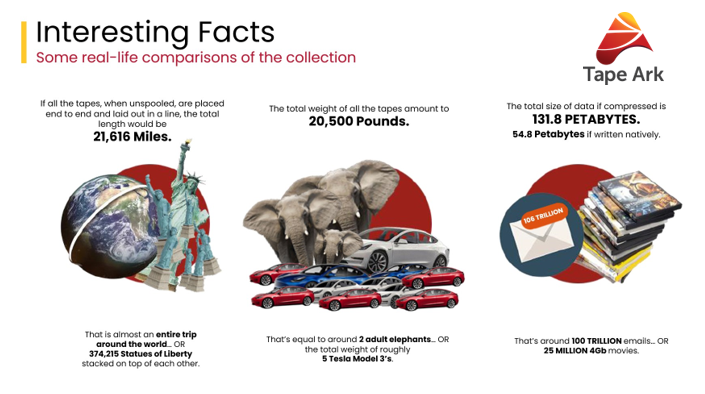As we enter the final stages of our project with one of the world’s largest telecommunications companies, it’s worth taking a look at how we’ve helped them so far and what they’ve got out of the project to date. The Tape Ark team has been as diligent as ever in making this another job well done, and our work with this company is a useful case study for spreading awareness about what we do. Out of respect for the company we have put a seal on their name and will only be referring to them in broad terms. After all, it’s not so much the company itself as the problems they were facing that is of interest to this article, given that these problems occur in all different businesses, in all different industries, all over the globe. It is our practice at Tape Ark to think in the macro while providing great solutions at a case-by-case level.
In 2022, the telecommunications company began to assess what options they had for the long-term preservation of data committed to their magnetic tape collections across their operations worldwide. This assessment was driven by the company’s aim to phase out the use of tape media and storage for future backups of the company’s systems, intuiting that there were better options available. As with other businesses that handle sensitive information, the company was required to permanently retain a lot of the data that they had on their systems, meaning that it couldn’t be disposed of or purged. They were conscious as well that in order to meet compliance, it isn’t enough to have the data there somewhere: unless they can produce the data when requested, they could be looking at very big fines.
This is why in 2023 the customer commissioned the Tape Ark team to perform a Comprehensive Media Audit (CMA) on all of the tapes in their repository. This is a service Tape Ark has designed to give a top-down assessment of large tape collections, so that the customer comes away with the following:
- an exact count of the number of tapes, along with the type and storage level of each.
- a knowledge of what content is on them.
- a knowledge of the condition each tape is in, with ones deemed “high-risk” being flagged for attention.
- a knowledge of what technology is end of life or unsupported.
- an accurate assessment of what data can be aged out (destroyed, expired, etc.)
The idea is that this information then enables them to make informed decisions about the data they’re storing: what is and isn’t of value to the company.
The customer estimated that they had around 37,000 tapes. Our first discovery was that this was 4,000 short. In reality, they had over 41,000.
Their initial thinking for this project was that we would catalog and audit their data so that in the future they’d be able to do restores knowing exactly where every tape was, and what equipment needed to read it. Yet our analysis found that a large proportion of their media (more than 30%, over 12,000 tapes) was at high-risk of data loss if left how it was, potentially putting their compliance in jeopardy. There were close to 20 tape types present from over 40 years of tape hardware, many of which had been end-of-life for years. Given that tape drives are not often backwards compatible, this meant the company was having to maintain almost a separate tape drive for each of their generations, without even knowing if those old tapes were still readable. Because tapes naturally degrade over time even if kept in the most optimal conditions at 40 years old this change was inevitable. What quickly became clear was that the customer’s initial idea of being given a directory which they could use to find their data whenever they needed, prior to performing a straightforward restore, was becoming more improbable the longer they left it. Unless they moved their data soon they would lose it forever.
To prevent this disaster from occurring, Tape Ark created an actionable plan to shift their data on high-risk tapes to cloud-based storage as swiftly as possible. We gave them recommended timeframes for dealing with moderate to manageable-risk data, with the option to preserve it in a different form if they chose. Not only was their data now properly cataloged and marked with different priority levels, we also drew up cost projections to show them the benefit of getting off tape. We estimated that their historical outlay on physical tape media and offsite storage (not including tape library costs, software licensing, or the human resources required for backups) was already upwards of USD 4 million. Moving the data to newer tape models (LTO8, or now LTO9) would cost them an additional $1 million just on the physical tapes alone. Taking into account the cost of reading the old tapes and writing the material over to the new ones, duplicating the data would cost over $4.5 million.
It is assumed that tape drive lifespans will continue to decrease as the technology is superseded more and more quickly. Once tapes or tape drives become end of life, they are no longer supported or maintained by manufacturers. This means companies are having to refresh their systems every few years just to keep their data accessible. We have put the groundwork in place for the customer to be able to break this cycle of costly infrastructure purchases when they are ready to move to the cloud.
At the same time, even just working with the systems they had, we helped them offload a lot of their tapes. We did this by applying a few different metrics to show them the problems that were draining their budget. Our CMA revealed that just 2 of their 20 tape types, LTO4 and LTO6 tapes – making up 60% of their tape count – accounted for 95% of their data. This meant that they could almost halve their collection in terms of the number of tapes that they had, and it would only mean moving 7% of their overall volume of data in petabytes. As they were keeping their tapes in offsite storage, it didn’t matter whether they were full or empty. Warehousing rates stay the same regardless of how much data you’re storing on the tapes. The customer is billed based on the number of tapes, so the content of the tapes isn’t part of the equation. This meant our customer was paying the same amount every month for a tape at full capacity as for one almost empty, though obviously with far less return on investment. This was one of the ways their legacy systems had been causing the company to leak money over time. It didn’t affect the price, of course, that a lot of those tapes were practically useless, or that their retention period had ended.
Using information we gleaned from the tapes and knowledge of the regulations observed by the customer, we were able to tag the tapes with their retention end-dates and signal which ones were due for disposal. With these end-dates logged in our system, we were automatically notified whenever a tape “expired”. We then made sure that these tapes were properly disposed of.
By doing this across their world operations, Tape Ark helped the customer in question to reduce their tape holding by almost 50%, condensing their 11 data centers in North America, South America, Europe, and the Indian Sub-Continent, to just the one data center at their HQ in the USA where they could centralize their restore function. In the process of doing so, saving the company a lot of money, time and resources.
Consolidating their data centers, shoring up their compliance routines, and stopping the leakage of company funds on wasted offsite offline storage – these are just three outcomes we delivered for the customer. Contact sales@tapeark.com to see how we can help you.




